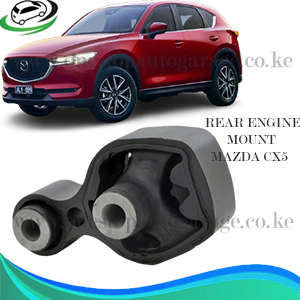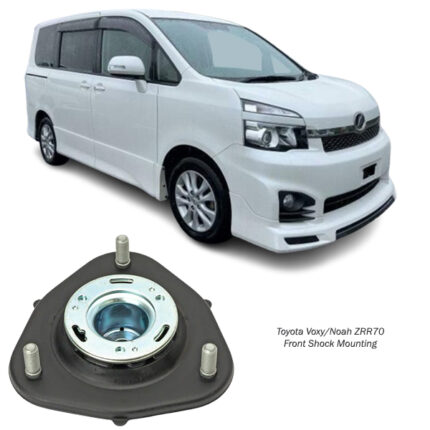-25%
Get Toyota Passo Rear Axle Carrier Bush 48725-52020 in Kenya
The rear axle carrier bush is a crucial component of a vehicle’s suspension system, designed to provide stability and support to the rear axle assembly. This comprehensive overview will explore the functions, design, maintenance, and importance of rear axle carrier bushes in automotive applications.
1. Understanding the Rear Axle Carrier Bush
a) Definition and Function
The rear axle carrier bush, often referred to simply as a “bush,” is an elastomeric component that serves as a mounting point for the rear axle assembly. It typically consists of a rubber or polyurethane material that isolates vibrations and absorbs shocks from the road. The primary functions of the rear axle carrier bush include:
- Vibration Damping: It reduces the transmission of vibrations and noise from the road to the vehicle chassis, enhancing passenger comfort.
- Alignment Maintenance: The bush helps maintain proper alignment of the rear axle, which is essential for optimal handling and tire wear.
- Load Support: It supports the weight of the vehicle and distributes loads evenly across the axle, ensuring stability during various driving conditions.
b) Importance in the Suspension System
The rear axle carrier bush is vital for the overall performance of the vehicle’s suspension system. It allows for controlled movement of the axle, ensuring that it can articulate over bumps and dips while maintaining contact with the road. A well-functioning rear axle carrier bush contributes to better handling, improved ride quality, and increased safety.
2. Design and Components
A rear axle carrier bush typically consists of several key components that contribute to its function:
a) Bush Material
- Rubber: Traditional rear axle carrier bushes are made from rubber, providing good vibration damping and flexibility. However, rubber can deteriorate over time due to exposure to heat, oil, and road salt.
- Polyurethane: Many modern vehicles utilize polyurethane bushes, which offer improved durability and resistance to wear. Polyurethane bushes provide better performance in handling and longevity compared to rubber.
b) Outer Housing
The outer housing of the rear axle carrier bush is designed to fit snugly within the axle carrier or frame of the vehicle. It provides a mounting point for the bush, allowing it to absorb loads while providing a stable connection.
c) Inner Sleeve
The inner sleeve is typically made of metal and provides a surface for the bolt or pin to pass through. It helps maintain the structural integrity of the bush while allowing for movement during suspension articulation.
3. Types of Rear Axle Carrier Bushes
There are several types of rear axle carrier bushes, each designed for specific applications and vehicle types:
a) Standard Bushes
These are the most common type of rear axle carrier bushes, providing adequate performance for everyday driving conditions. They are designed to absorb shocks and vibrations effectively.
b) Performance Bushes
Performance-oriented vehicles often utilize upgraded rear axle carrier bushes made of high-quality materials, such as polyurethane. These bushes provide improved handling, responsiveness, and durability, making them suitable for sports and racing applications.
c) Adjustable Bushes
Some vehicles feature adjustable rear axle carrier bushes, allowing for fine-tuning of suspension geometry. This can be particularly beneficial for racing or off-road vehicles, where precise alignment and handling characteristics are critical.
4. Signs of Worn Rear Axle Carrier Bushes
Over time, rear axle carrier bushes can wear out due to constant exposure to stress, heat, and environmental factors. Here are some common signs that indicate a need for inspection or replacement:
a) Noise
If the vehicle produces clunking, banging, or squeaking noises when driving over bumps or rough terrain, it may indicate worn or damaged rear axle carrier bushes. These noises can be due to increased movement of the axle assembly.
b) Vibration
Excessive vibrations felt in the cabin, especially during acceleration or deceleration, can signal that the rear axle carrier bushes have deteriorated. Worn bushes may allow for unwanted movement of the axle, resulting in vibrations transmitted to the chassis.
c) Alignment Issues
If the vehicle pulls to one side or exhibits uneven tire wear, it may indicate that the rear axle is not properly aligned. Worn carrier bushes can lead to misalignment, affecting handling and safety.
d) Visual Inspection
A visual inspection of the rear axle carrier bushes can reveal signs of wear, such as cracks, tears, or splitting in the bush material. If any damage is evident, it is essential to replace the bushes promptly.
5. Maintenance of Rear Axle Carrier Bushes
Proper maintenance of rear axle carrier bushes is essential for ensuring their longevity and performance. Here are some maintenance tips:
a) Regular Inspections
Routine inspections of the rear axle carrier bushes should be part of vehicle maintenance. Look for signs of wear or damage, such as cracks, tearing, or excessive movement in the bush.
b) Lubrication
Some rear axle carrier bushes may require periodic lubrication to reduce friction and wear. Follow the manufacturer’s recommendations for lubrication intervals and procedures.
c) Replacement
If any signs of wear or damage are present, timely replacement of the rear axle carrier bushes is essential. Delaying replacement can lead to further suspension damage and increased repair costs.
6. Installation of Rear Axle Carrier Bushes
Proper installation of rear axle carrier bushes is crucial for ensuring optimal performance. Here’s a general guide to installation:
a) Tools Required
- Wrenches and socket sets
- Torque wrench
- Pry bar
- Bushing removal and installation tools
- Lubricant
b) Steps for Installation
- Lift the Vehicle: Use a jack to lift the vehicle and secure it with jack stands. Ensure the vehicle is stable before working underneath.
- Remove the Old Bushes: Use the appropriate tools to remove the old rear axle carrier bushes. This may involve pressing them out or using a pry bar to assist with removal.
- Clean the Housing: Before installing new bushes, clean the housing where the bushes will be seated. Remove any debris, rust, or old lubricant to ensure a proper fit.
- Install New Bushes: Apply lubricant to the outer surface of the new rear axle carrier bushes. Use a bushing installation tool to press the new bushes into place, ensuring they are seated correctly.
- Reassemble the Axle Assembly: Once the new bushes are installed, reassemble the rear axle assembly, tightening all fasteners according to the manufacturer’s torque specifications.
- Check Alignment: After installation, it’s essential to have a professional alignment performed to ensure proper vehicle handling and tire wear.
7. Conclusion
The rear axle carrier bush is a vital component of a vehicle’s suspension system, providing stability, comfort, and control while driving. Understanding the function, types, and maintenance of rear axle carrier bushes can help vehicle owners ensure a safe and comfortable driving experience. Regular inspections and timely replacements are crucial to preventing suspension issues and maintaining overall vehicle performance. By prioritizing the health of rear axle carrier bushes, drivers can enhance their vehicle’s handling, prolong component life, and ensure safety on the road.
Follow us on Facebook for more parts.



